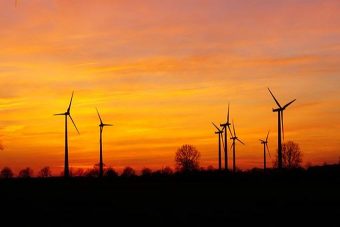
Over the next ten years, China is expected to install an annual average of more than 25 gigawatts of new wind capacity, resulting in a cumulative growth across the decade of about 403 gigawatts, according to new figures from MAKE Consulting.
Renewable energy analysts MAKE Consulting published its China Wind Power Outlook 2017 report this week, in which it analyzes the Chinese wind energy industry and predicts its path across the next ten years. Between 2017 and 2020, curtailment issues and policy restraints are expected to restrict annual wind energy capacity additions to below 25 gigawatts (GW), but beyond that, grid-connected wind energy capacity is expected to increase. Over the next ten years between 2017 and 2026, MAKE predicts that an average of in excess of 25 GW will be added annually (obviously backloaded to post-2020) to result in a cumulative 10-year capacity addition of 403 GW.
As of the end of 2016, China had installed 23 GW of new wind capacity, bringing its cumulative total up to 168.7 GW, following on from a record-breaking 2015, when it installed 30.5 GW of new wind. However, China’s big issue for new wind capacity is curtailment issues, where wind turbines are not necessarily connected to the grid, or when electricity generated is simply lost along the way. This has been a big issue in China for some time, and while China is moving to address these issues, we’re not likely to see ready fixes until the beginning of the next decade.
The Chinese National Energy Administration (NEA) instituted a new alert system that would provide warnings — red, orange, or green — to states and regions in an effort to prevent further investment in wind power capacity due to curtailment issues. At the launch of the system, China gave a red alert to five provinces — Jilin and Heilongjiang in northeast China, and Gansu, Ningxia and Xinjiang province in western China — nearly all of which are the traditional wind regions. As a result, curtailment issues have grown so large that policy has been enacted to minimize further problems.
Nevertheless, the NEA, in the Thirteenth Five-Year Plan for Wind Power published in November of last year, set its targets at 210 GW worth of grid-connected capacity and the wind power generation target at 420 TWh, each by the end of 2020. The NEA also introduced a green certification system to support the country’s non-hydro Renewable Portfolio Standard (RPS) target by 2020. The NEA also reduced the onshore wind feed-in tariff levels across three consecutive years from 2014 to 2016, in an effort to lighten the burden of subsidy funding for renewable energy sources. The Chinese Government is therefore set to publish at least 2 or 3 additional reductions to the onshore wind FiT level before 2023.
Already this year, China’s wind capacity increased 13% in the first quarter over the same quarter a year ago, bringing the country’s cumulative wind energy capacity up to 151 GW. Capacity additions were focused in the provinces of Qinghai, Shaanxi, Henan, and Hebei saw the largest wind energy capacity increases during the first quarter of 2017.
The Chinese offshore wind industry is also expected to get a boost, according to MAKE Consulting, and is expected to begin adding GW-level capacity annually by 2018. By 2026, MAKE predicts that China’s cumulative grid-connected offshore wind capacity could reach 26 GW.
Source: cleantechnica.com



